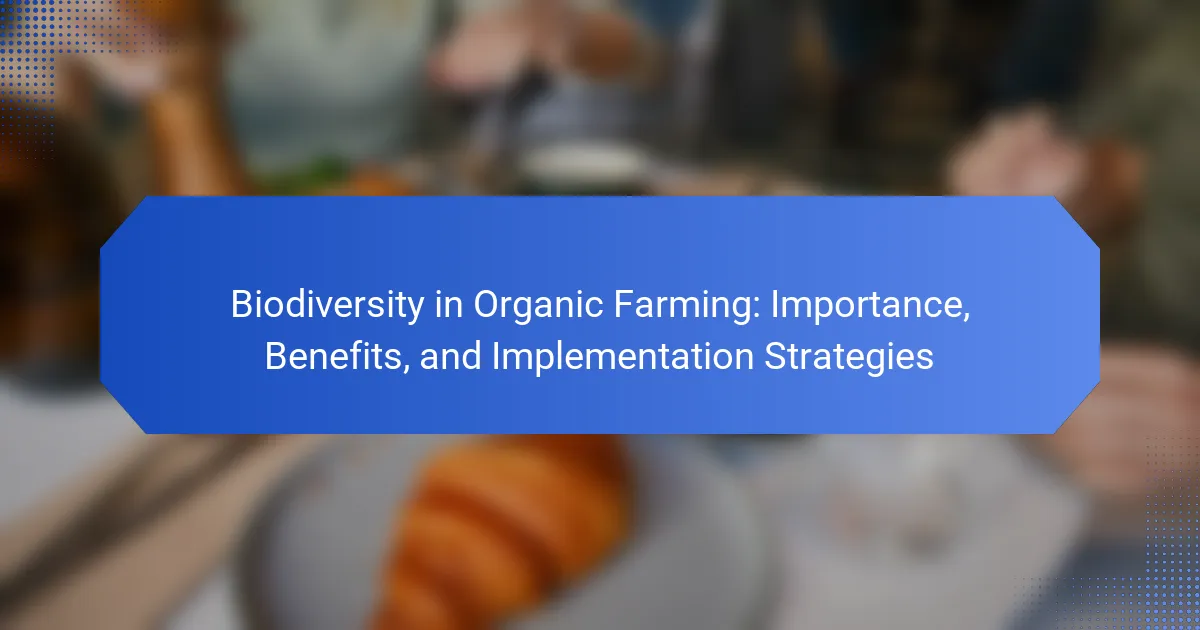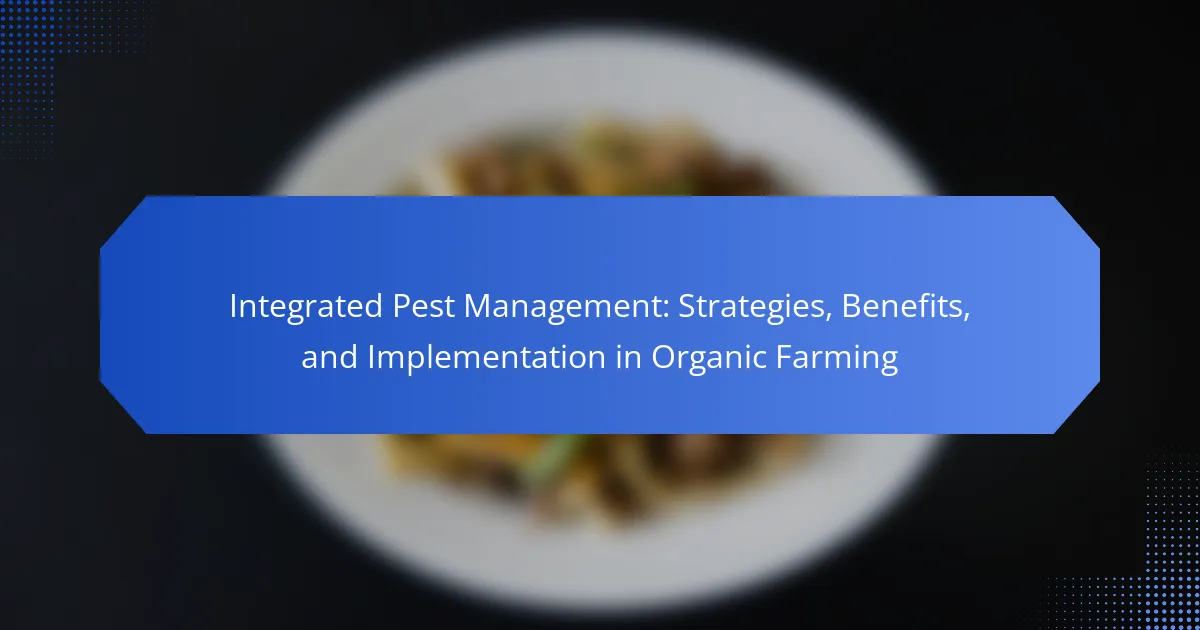Crop rotation is a sustainable farming practice that enhances agricultural productivity through improved nutrient management, soil fertility, and pest control. This method involves alternating deep-rooted and shallow-rooted crops, which allows for optimal nutrient utilization from various soil layers. Additionally, crop rotation aids in pest and disease management by disrupting the life cycles of specific pests, while also reducing soil erosion by maintaining ground cover. Research indicates that implementing crop rotation can lead to yield increases of up to 20% compared to monoculture systems, promoting biodiversity and improving soil structure in the process.

What are the benefits of crop rotation?
Crop rotation offers several benefits that enhance agricultural productivity. It improves soil fertility by alternating deep-rooted and shallow-rooted crops. This practice allows different crops to utilize nutrients from various soil layers. Crop rotation also helps in pest and disease management. By changing the crop type, pests specific to one plant are less likely to thrive. Additionally, it reduces soil erosion by maintaining ground cover. Research shows that crop rotation can increase yields by up to 20% compared to monoculture systems. This practice also promotes biodiversity and improves soil structure. Overall, crop rotation is a sustainable farming practice that supports healthy ecosystems.
How does crop rotation contribute to nutrient management?
Crop rotation contributes to nutrient management by enhancing soil fertility and reducing nutrient depletion. Different crops have varying nutrient requirements and uptake patterns. For example, legumes fix nitrogen in the soil, improving nitrogen availability for subsequent crops. Rotating crops helps break pest and disease cycles, minimizing the need for chemical fertilizers. Research shows that diverse rotations can increase overall soil organic matter, which supports nutrient retention. Studies indicate that farms practicing crop rotation can yield up to 20% more than those using monoculture. Thus, crop rotation is a proven strategy for sustainable nutrient management.
What specific nutrients are affected by crop rotation?
Crop rotation primarily affects nitrogen, phosphorus, and potassium levels in the soil. Different crops have varying nutrient requirements and uptake patterns. For instance, legumes enhance nitrogen levels through nitrogen fixation. Meanwhile, deep-rooted plants can access nutrients from deeper soil layers. This results in improved nutrient availability for subsequent crops. Studies show that crop rotation can increase soil fertility and enhance nutrient cycling. Research indicates that diverse crop rotations lead to better nutrient balance and soil health.
How does crop rotation enhance nutrient availability in soil?
Crop rotation enhances nutrient availability in soil by alternating different types of crops in a specific sequence. This practice prevents nutrient depletion by varying the nutrient demands of different plants. For example, legumes can fix nitrogen in the soil, enriching it for subsequent crops. Additionally, rotating deep-rooted and shallow-rooted plants can improve soil structure and nutrient access. Research shows that crop rotation can increase overall soil fertility and crop yields by up to 20%. This method also reduces soil erosion and promotes a healthier microbial community, further supporting nutrient cycling.
In what ways does crop rotation improve soil fertility?
Crop rotation improves soil fertility by enhancing nutrient availability and reducing soil degradation. Different crops have varying nutrient requirements and root structures. This diversity allows for better nutrient utilization from the soil. For instance, legumes fix nitrogen in the soil, enriching it for subsequent crops. Additionally, rotating crops helps break pest and disease cycles. This reduces the need for chemical fertilizers and pesticides. Research indicates that crop rotation can increase yields by up to 20% compared to monoculture systems. Overall, these practices lead to healthier soil and sustainable agricultural systems.
What are the indicators of improved soil fertility through crop rotation?
Indicators of improved soil fertility through crop rotation include increased soil organic matter, enhanced nutrient availability, and improved soil structure. Crop rotation introduces diverse root systems that contribute to organic matter. This organic matter improves moisture retention and nutrient cycling. Additionally, rotating crops can reduce soil compaction. It also promotes beneficial microbial activity in the soil. These factors collectively lead to higher crop yields. Research shows that crop rotation can increase nitrogen levels in the soil, benefiting subsequent crops. Studies indicate that fields with diverse rotations have better soil health than monoculture systems.
How does crop rotation influence soil structure and composition?
Crop rotation enhances soil structure and composition by promoting diverse root systems. Different crops contribute varying organic matter to the soil. This organic matter improves soil aggregation and aeration. Enhanced aeration allows for better water infiltration and root [censured]. Crop rotation also helps break pest and disease cycles. This leads to healthier soil microbiomes. Studies show that rotating legumes with grains increases nitrogen levels. Increased nitrogen improves soil fertility and plant growth.
How does crop rotation assist in pest control?
Crop rotation assists in pest control by disrupting the life cycles of pests. Different crops attract various pests and beneficial insects. Changing crops reduces the availability of food and habitat for pests. This practice lowers pest populations over time. Research shows that rotating crops can decrease pest infestations by up to 50%. For example, alternating between legumes and cereals can disrupt pests like aphids and root worms. This method also promotes a diverse ecosystem, enhancing natural pest predators. Overall, crop rotation is an effective strategy for sustainable pest management.
What types of pests can be managed through crop rotation?
Crop rotation can manage various types of pests, including nematodes, aphids, and root maggots. Nematodes are soil-dwelling pests that can be reduced by alternating crops. Different crops disrupt the life cycles of nematodes, limiting their population growth. Aphids, which feed on plant sap, can be deterred by planting non-host crops in rotation. This disrupts their reproduction and reduces infestations. Root maggots, which affect crops like cabbage, can also be managed by rotating with crops that are not susceptible to them. Studies show that crop rotation effectively lowers pest populations and improves crop health.
How does crop rotation disrupt pest life cycles?
Crop rotation disrupts pest life cycles by altering the habitat and food sources available to pests. When different crops are planted in succession, pests that rely on specific plants for survival cannot thrive. For example, if a pest is adapted to feed on a particular crop, rotating to a different crop can starve the pest. This method reduces the population density of pests over time. Studies show that crop rotation can lower pest infestation rates significantly. Research indicates that rotating crops can reduce the need for chemical pesticides. This practice promotes a healthier ecosystem by encouraging natural pest predators. Overall, crop rotation is an effective strategy for integrated pest management.
What are the long-term benefits of implementing crop rotation?
Implementing crop rotation offers several long-term benefits. It enhances soil fertility by improving nutrient availability. Different crops contribute various nutrients to the soil. For instance, legumes fix nitrogen, enriching the soil for subsequent crops. Crop rotation also reduces soil erosion by maintaining soil structure and preventing depletion. Additionally, it disrupts pest and disease cycles, reducing infestations over time. Research shows that farms practicing crop rotation experience higher yields and better soil health. A study by the USDA in 2019 confirmed that crop rotation leads to a 20% increase in soil organic matter. These benefits cumulatively support sustainable agricultural practices.
How does crop rotation impact crop yields over time?
Crop rotation positively impacts crop yields over time. It enhances soil fertility by alternating crops with different nutrient requirements. This practice reduces soil depletion and increases nutrient availability. Crop rotation also disrupts pest and disease cycles, leading to healthier plants. Research indicates that farms practicing crop rotation can see yield increases of 10-25%. For example, a study by the University of Illinois found that rotating corn and soybeans improved yields significantly compared to continuous cropping. This method fosters biodiversity and improves soil structure, further benefiting crop production.
What role does crop rotation play in sustainable agriculture?
Crop rotation plays a crucial role in sustainable agriculture by enhancing soil health and fertility. It involves alternating different crops in a specific sequence over time. This practice helps prevent soil depletion by replenishing nutrients. For instance, legumes can fix nitrogen in the soil, benefiting subsequent crops. Crop rotation also disrupts pest and disease cycles. By changing the crop type, pests that thrive on specific plants are less likely to survive. Research indicates that crop rotation can increase yields by 10-20% compared to monoculture systems. Additionally, it reduces the need for chemical fertilizers and pesticides, promoting environmental sustainability.
How can farmers effectively implement crop rotation practices?
Farmers can effectively implement crop rotation practices by planning diverse crop sequences. This involves alternating different crops in a specific order over several growing seasons. For example, rotating legumes with cereals improves soil nitrogen levels. Crop rotation reduces pest and disease buildup by disrupting their life cycles. Farmers should analyze soil health and nutrient needs before selecting crops. Implementing cover crops during off-seasons enhances soil structure and prevents erosion. Research indicates that crop rotation can increase yields by 10-25% compared to monoculture systems. Overall, strategic crop rotation enhances nutrient management, soil fertility, and pest control.
What are the best strategies for planning a crop rotation schedule?
The best strategies for planning a crop rotation schedule include alternating crops with different nutrient needs. This prevents nutrient depletion in the soil. For example, legumes can replenish nitrogen levels. Incorporating cover crops can improve soil structure and prevent erosion.
Timing is crucial; plan rotations based on local climate and growing seasons. Consider pest and disease cycles when selecting crops to minimize outbreaks. Diversifying crops can disrupt pest habitats, reducing infestations.
Documenting past crop yields and soil health helps refine future rotations. Research indicates that effective crop rotation can increase yields by up to 20% (source: “Crop Rotation and Soil Health,” USDA).
What common challenges do farmers face with crop rotation?
Farmers face several common challenges with crop rotation. One challenge is the complexity of planning rotations. Farmers must consider crop compatibility and nutrient needs. This requires knowledge and experience. Another challenge is pest management. Some pests may thrive on specific crops, complicating control efforts. Additionally, crop rotation can lead to inconsistent yields. This may occur if the rotation disrupts established soil health. Economic factors also pose challenges. Farmers may incur costs for new seeds or equipment. Weather variability can impact crop success in rotation systems. These challenges necessitate careful management and adaptation strategies.
What resources are available for learning more about crop rotation benefits?
Resources for learning about crop rotation benefits include academic journals, extension services, and online courses. The Journal of Sustainable Agriculture publishes research on crop rotation practices. The USDA Cooperative Extension Service offers guides and workshops on nutrient management through crop rotation. Websites like the Sustainable Agriculture Research and Education (SARE) program provide extensive resources and case studies. Additionally, universities often have agriculture departments that publish research and host seminars on soil fertility and pest control related to crop rotation. These resources collectively offer valuable insights into the benefits of crop rotation.
The main entity of the article is crop rotation, a sustainable agricultural practice that enhances soil fertility, nutrient management, and pest control. The article outlines the benefits of crop rotation, including improved soil health through diverse nutrient uptake, increased yields by up to 20%, and effective pest management by disrupting pest life cycles. It discusses specific nutrients affected by crop rotation, indicators of improved soil fertility, and strategies for implementing effective crop rotation schedules. Additionally, the article addresses common challenges farmers face and provides resources for further learning about crop rotation benefits.



